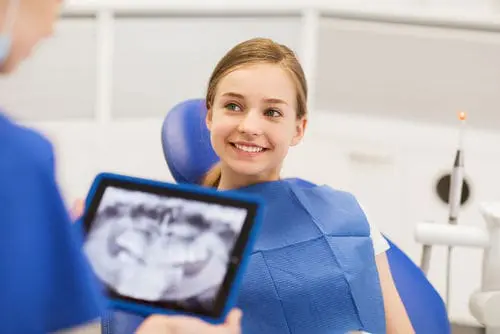Proudly serving Newton MA and surrounding towns.
Even with regular preventative care, pediatric dental extractions are occasionally necessary. Although it’s our goal to help your child preserve their teeth as long as possible, removal may be necessary when extreme circumstances present themselves.

Reasons for Extracting Baby Teeth
Here are some of the most common scenarios where a dental extraction is recommended for children:
Emergencies — Dental emergencies pop up when you least expect them. And if your child is involved in extracurricular athletic activities, they’re even more prone to an oral injury. Sometimes an emergency tooth extraction is the best thing to do to help get them out of pain a quickly as possible. Most of these instances are completely accidental, but others tend to link back to untreated tooth decay.
Severe Tooth Decay — We want to do everything possible to preserve natural teeth. Especially in children, since their mouths are still developing. But if a tooth is so damaged by a cavity to the point it can’t be repaired, removing it is the only option. Cavities can spread into adjacent teeth, including developing adult teeth underneath baby teeth, so it’s vital to remove the source of infection from your child’s mouth.
Orthodontic Concerns — Although rare, there are still instances where orthodontists and dental specialists will suggest having teeth removed to create extra space in the jaws. Usually it’s one set of premolars (bicuspids) which are the teeth located between the eye teeth and molars.
Dental Abscesses — Aggressive dental abscesses can pose serious and even life-threatening infections. If the tooth is non-restorable due to the extent of the infection, removal is likely the best choice.
Non-resorbing Roots — Primary (baby) teeth are designed in such a way that they naturally resorb (shrink) as the adult tooth underneath them becomes more mature. As the root resorbs, it creates space for its replacement. But if a root fails to shrink like it ought to, it can result in orthodontic complications and may need to be extracted.
Milk Teeth — Although rare, some infants are born with tooth-like buds inside of their gums. Most people prefer to these neonatal teeth as “milk teeth.” As you might guess, they can interfere with breastfeeding or bottle feeding. Removal is straightforward, as milk teeth do not usually have fully sized roots.
Supernumerary Teeth — Some people have “extra” teeth that don’t line up with the number that are supposed to be there. Supernumerary and missing teeth tend to run in families. So, if you or your child’s other parent have a history of missing and extra teeth, they could too.
Space Maintainers After Extractions
Removing a tooth from a developing smile can permanently alter the alignment of the teeth and how the jaws line up. To prevent complications such as impacted teeth or orthodontic concerns, retaining that space is essential. But since you no longer have a tooth to serve as a placeholder, something else must be used. In this case, it’s something we call a “space maintainer” or a “band and loop.”
Space maintainers are temporary devices that attach to the tooth immediately next to the one that was removed. There is a small loop that extends out the side, reaching across the open space to the tooth on the opposing side. By filling in this space, the device prevents either tooth from collapsing into the newly created opening. As such, it prevents the permanent tooth underneath from becoming impacted in the bone.
Although temporary in nature, space maintainers are a must-have if your child’s mouth is still developing. Their effectiveness can greatly reduce the risk of orthodontic complications caused by premature tooth loss.
Ensuring Your Child’s Comfort
Having a tooth pulled can be quite straightforward. However, we still want to take specific measures to ensure your child’s comfort throughout the procedure. After applying numbing gel, we’ll use local anesthetic to thoroughly numb the area immediately surrounding the tooth. As the tooth is extracted, the only thing your child should feel is a bit of pressure. We tend to do a good job of distracting them enough that they don’t realize anything is going on. Before they know it, the procedure is over!
Be sure to have your child wait a few hours before eating anything, as the anesthetic will take some time to wear off. It’s best to keep clean gauze and a slight amount of pressure over the extraction site to help with any bleeding.
Does My Child Need Their Tooth Pulled?
Contact our office today to reserve an appointment. During your child’s exam we’ll discuss our findings, recommendations, and answer any questions you may have. Call (617) 527-6061 or request an appointment online.







